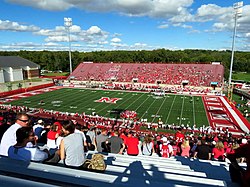 View from the west grandstand | |
 Interactive map of Yager Stadium | |
| Location | Weeb Ewbank Way Oxford, Ohio 45056 |
|---|---|
| Coordinates | 39°31′10″N84°43′58″W / 39.51944°N 84.73278°W |
| Owner | Miami University |
| Operator | Miami University |
| Capacity | 24,286 (2005–present) [1] 30,012 (1995–2004) [2] 25,183 (1983–1994) [2] |
| Record attendance | 30,087 (October 2, 1999 vs Marshall) [3] |
| Surface | FieldTurf (2003–present) Natural Grass (1983–2002) |
| Construction | |
| Broke ground | 1982 |
| Opened | October 1, 1983 |
| Renovated | 2003–2005 |
| Construction cost | $13.5 million ($42.6 million in 2024 dollars [4] ) |
| Architect | Clough, Harbour & Associates (renovations) |
| Tenants | |
| Miami RedHawks (NCAA) (1983–present) | |
Yager Stadium is a football stadium in Oxford, Ohio, United States, on the campus of Miami University. It is home to the Miami RedHawks football team. Built in 1983, the stadium has a seating capacity of 24,286. [1] It replaced Miami Field, which had been used since 1895. The stadium is named for Fred C. Yager, class of 1914, who was the lead benefactor in stadium's construction.
